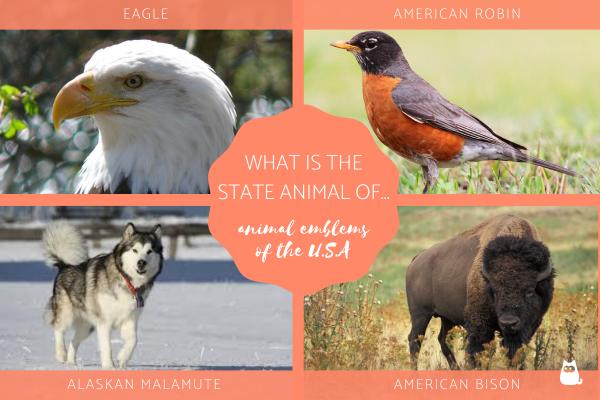
Each country has their own national animal. In the United States there is also a corresponding state animal, including a mammal, fish, dog or even reptile.
In this AnimalWised article, we're going to give you a complete list of all the state animals and national animals of the United States. Continue reading to learn more!
What are the state animals or animal emblems of the U.S.?
The national bird of the United States is the bald eagle (Haliaeetus leucocephalus) and the national mammal is the American bison (Bison bison).
To reflect the huge size and rich diversity of habitats and ecosystems of the U.S., each state has designated its own state mammal, fish, bird, reptile, insect, amphibian, and even dog breed. However, not all states have all animal emblems, since they must be debated, voted and made official. Occasionally, consensus cannot be found.
As you will see, some animal emblems are shared by different states. This is because those species are widespread and popular enough to become iconic across wide regions. Are you wondering what the state animal is where you live? Keep reading to find out!
What is the state mammal of...?
- Alabama: American black bear (Ursus americanus)
- Alaska: Moose (Alces alces) and bowhead whale (Balaena mysticetus)
- Arizona: Ring-tailed cat (Bassariscus astutus)
- Arkansas: White-tailed deer (Odocoileus virginianus)
- California: California grizzly bear (Ursus arctos californicus) and gray whale (Eschrichtius robustus)
- Colorado: Rocky Mountain bighorn (Ovis canadensis)
- Conneticut: Sperm whale (Physeter macrocephalus)
- Delaware: Grey fox (Urocyon cinereoargenteus)
- Florida: Florida panther (Puma concolor coryi), West Indian manatee (Trichechus manatus) and common bottlenose dolphin (Tursiops truncatus)
- Georgia: White-tailed deer and North Atlantic right whale (Eubalena glacialis)
- Hawaii: Hawaiian monk seal (Neomonachus schauinslandi) and humpback whale (Megaptera novaeangliae)
- Idaho: Appaloosa horse (Equus ferus caballus)
- Illinois: White-tailed deer
- Kansas: American bison (Bison bison)
- Kentucky: Eastern gray squirrel (Sciurus carolinensis)
- Louisiana: American black bear
- Maine: Moose
- Maryland: Thoroughbred horse
- Massachusetts: North Atlantic right whale
- Michigan: White-tailed deer
- Mississipi: White-tailed deer and common bottlenose dolphin
- Missouri: Missouri mule (Equus asinus x Equus caballus)
- Montana: Grizzly bear (Ursus arctos)
- Nebraska: White-tailed deer
- Nevada: Desert bighorn sheep (Ovis canadensis nelsoni)
- New Hampshire: White-tailed deer
- New Jersey: Horse
- New Mexico: American black bear
- New York: North American beaver (Castor canadensis)
- North Carolina: Eastern gray squirrel
- North Dakota: Nokota horse
- Ohio: White-tailed deer
- Oklahoma: American bison
- Oregon: North American beaver
- Pennsylvania: White-tailed deer
- Rhode Island: Harbor seal (Phoca vitulina)
- South Carolina: White-tailed deer, common bottlenose dolphin and North Atlantic right whale
- South Dakota: Coyote (Canis latrans)
- Tennessee: Raccoon (Procyon lotor)
- Texas: Nine-banded armadillo (Dasypus novemcinctus) and Texas longhorn cow (Bos taurus)
- Utah: Rocky Mountain elk (Cervus canadensis nelsoni)
- Vermont: Morgan horse
- Virginia: Virginia big-eared bat (Corynorhinus townsendii virginianus)
- Washington: Olympic marmot (Marmota olympus) and orca (Orcinus orca)
- West Virginia: American black bear
- Wisconsin: American badger (Taxidea taxus)
- Wyoming: American bison
In the picture below you can see a male white-tailed deer.
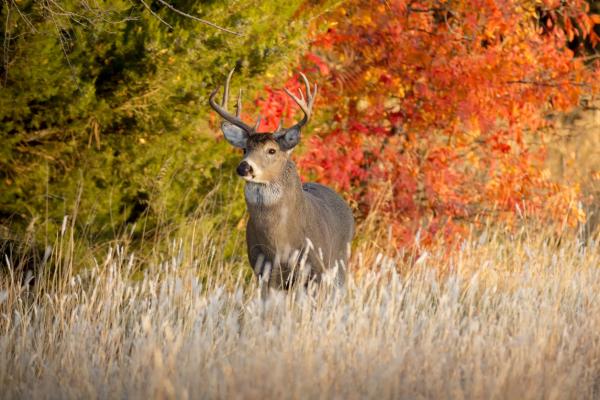
What is the state dog breed of...?
Not all states have chosen a dog breed as a state emblem, and some are currently in the process of choosing and accepting a state dog breed to represent them. The U.S. states that have designated a dog breed have chosen them because they are native breeds to that state or because they were introduced very early on.
- Alaska: Alaskan Malamute
- Delaware: Golden Retriever
- Louisiana: Catahoula Leopard dog
- Maryland: Chesapeake Bay Retriever
- Massachusetts: Boston Terrier
- New Hampshire: Chinook
- North Carolina: Plott Hound
- Pennsylvania: Great Dane
- South Carolina: Boykin Spaniel
- Texas: Blue Lacy
- Virginia: American Foxhound
- Wisconsin: American water spaniel
Georgia chose the "adoptable dog" as a state dog in 2016 in order to honor and promote the work of shelters and dog lovers who decide to adopt a pet regardless of their breed. Colorado also chose all adopted dogs and cats as official state pets. California honored all shelter animals as well.
In the picture below you can see an American water spaniel.

What is the state bird of...?
- Alabama: Northern flicker (Colaptes auratus)
- Alaska: Willow ptarmigan (Lagopus lagopus)
- Arizona: Cactus wren (Campylorhynchus brunneicapillus)
- Arkansas: Northern mockingbird (Mimus polyglottos)
- California: California quail (Callipepla californica)
- Colorado: Lark bunting (Calamospiza melanocorys)
- Connecticut: American robin (Turdus migratorius)
- Delaware: Delaware blue hen (Gallus gallus)
- Florida: Northern mockingbird
- Georgia: Brown thrasher (Toxostoma rufum)
- Hawaii: Hawaiian goose (Branta sandvicensis)
- Idaho: Mountain bluebird (Sialia currucoides)
- Illinois: Northern cardinal (Cardinalis cardinalis)
- Indiana: Northern cardinal
- Iowa: Eastern goldfinch (Spinus tristis)
- Kansas: Western meadowlark (Sturnella neglecta)
- Kentucky: Northern cardinal
- Louisiana: Brown pelican (Pelecanus occidentalis)
- Maine: Black-capped chickadee (Poecile atricapilla)
- Maryland: Baltimore oriole (Icterus galbula)
- Massachusetts: Black-capped chickadee
- Michigan: American robin
- Minnesota: Common loon (Gavia immer)
- Mississipi: Northern mockingbird
- Missouri: Eastern bluebird (Sialia sialis)
- Montana: Western meadowlark
- Nebraska: Western meadowlark
- Nevada: Mountain bluebird
- New Hampshire: Purple finch (Carpodacus purpureus)
- New Jersey: Eastern goldfinch
- New Mexico: Roadrunner (Geococcyx californianus)
- New York: Easter bluebird
- North Carolina: Northern cardinal
- North Dakota: Western meadowlark
- Ohio: Northern cardinal
- Oklahoma: Scissor-tailed flycatcher (Tyrannus forficatus)
- Oregon: Western meadowlark
- Pennsylvania: Ruffed grouse (Bonasa umbellus)
- Rhode Island: Rhode Island red hen
- South Carolina: Carolina wren (Thryothorus ludovicianus)
- South Dakota: Ring-necked pheasant (Phasianus colchicus)
- Tennessee: Northern mockingbird
- Texas: Northern mockingbird
- Utah: California gull (Larus californicus)
- Vermont: Hermit thrush (Catharus guttatus)
- Virginia: Northern cardinal
- Washington: Eastern goldfinch
- West Virginia: Northern cardinal
- Wisconsin: American robin
- Wyoming Western meadowlark
In the picture below you can see a Northern cardinal.
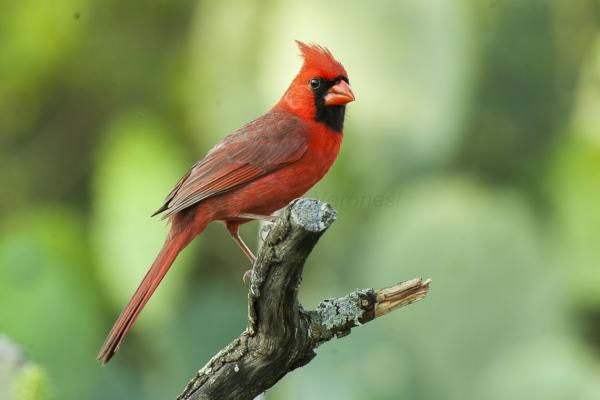
What is the state fish of...?
- Alabama: Largemouth bass (Micropterus salmoides) and fighting tarpon (Megalops atlanticus)
- Alaska: King salmon (Oncorhynchus tshawytscha)
- Arizona: Apache trout (Oncorhynchus gilae apache)
- Arkansas: None
- California: Golden trout (Oncorhynchus mykiss aguabonita) and garibaldi (Hypsypops rubicundus)
- Colorado: Greenback cutthroat trout (Oncorhynchus clarki stomias)
- Connecticut: American shad (Alosa sapidissima)
- Delaware: Weakfish (Cynoscion regalis)
- Florida: Florida largemouth bass (Micropterus salmoides floridanus) and Atlantic sailfish (Istiophorus albicans)
- Georgia: Largemouth bass
- Hawaii: Humuhumunukunukuapua'a (Rhinecanthus rectangulus)
- Idaho: Cutthroat trout (Oncorhynchus clarki)
- Illinois: Bluegill (Lepomis macrochirus)
- Indiana: Largemouth bass
- Iowa: Channel catfish (Ictalurus punctatus)
- Kansas: None
- Kentucky: Kentucky spotted bass (Micropterus punctulatus)
- Louisiana: White crappie (Pomoxis annularis)
- Maine: Atlantic salmon (Salmo salar)
- Maryland: Striped bass (Morone saxatilis)
- Massachusetts: Cod (Gadus morhua)
- Michigan: Brook trout (Salvelinus fontinalis)
- Minnesota: Walleye (Sander vitreus)
- Mississippi: Largemouth bass
- Missouri: Channel catfish and paddlefish (Polyodon spathula)
- Montana: Cutthroat trout
- Nebraska: Channel catfish
- Nevada: Lahontan cutthroat trout (Oncorhynchus clarki henshawi)
- New Hampshire: Brook trout and striped bass
- New Jersey: Brook trout
- New Mexico: Rio Grande cutthroat trout (Oncorhynchus clarki virginalis)
- New York: Brook trout and striped bass
- North Carolina: Channel bass (Sciaenops ocellatus) and brook trout
- North Dakota: Northern pike (Esox lucius)
- Ohio: None
- Oklahoma: White bass (Morone chrysops)
- Oregon: Chinook salmon (Oncorhynchus tshawytscha)
- Pennsylvania: Brook trout
- Rhode Island: Striped bass
- South Carolina: Striped bass
- South Dakota: Walleye
- Tennessee: Largemouth bass and Channel catfish
- Texas: Guadalupe bass (Micropterus treculii)
- Utah: Bonneville cutthroat trout (Oncorhynchus clarki utah)
- Vermont: Brook trout and walleye
- Virginia: Brook trout and striped bass
- Washington: Steelhead trout (Oncorhynchus mykiss)
- West Virginia: Brook trout
- Wisconsin: Muskellunge (Esox masquinongy)
- Wyoming: Cutthroat trout
In the picture you can see a reef trigger fish, also called humuhumunukunukuapua'a.
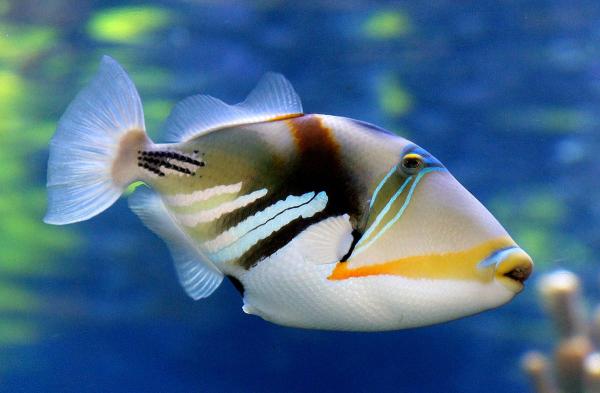
What is the state reptile of...?
Not all U.S. states have designed a state reptile yet. The ones that have chosen a reptile species to represent them are the following:
- Alabama: Alabama red-bellied turtle (Pseudemys alabamensis)
- Arizona: Arizona ridge-nosed rattlesnake (Crotalus willardi willardi)
- California: Desert tortoise (Gopherus agassizii)
- Colorado: Western painted turtle (Chrysemys picta bellii)
- Florida: American alligator (Alligator mississippiensis), loggerhead sea turtle (Caretta caretta) and gopher tortoise (Gopherus polyphemus)
- Georgia: Gopher tortoise
- Illinois: Painted turtle (Chrysemys picta)
- Kansas: Ornate box turtle (Terrapene ornata)
- Lousiana: American alligator
- Maryland: Diamond terrapin (Malaclemys terrapin)
- Massachusetts: Garter snake (Thamnophis)
- Michigan: Painted turtle
- Mississippi: American alligator
- Missouri: Three-toed box turtle (Terrapene carolina triunguis)
- Nevada: Desert tortoise (Gopherus agassizii)
- New Mexico: New Mexico whiptail lizard (Cnemidophorus neomexicanus)
- New York: Common snapping turtle (Chelydra serpentina)
- North Carolina: Eastern box turtle (Terrapene carolina carolina)
- Ohio: Northern black racer (Coluber constrictor constrictor)
- Oklahoma: Common collared lizard (Crotaphytus collaris)
- South Carolina: Loggerhead sea turtle
- Tennessee: Eastern box turtle
- Texas: Texas horned lizard (Phrynosoma cornutum)
- Vermont: Painted turtle
- West Virginia: Timber rattlesnake (Crotalus horridus)
- Wyoming: Horned lizard (Phrynosoma)
Here you can learn more about the difference between alligators and crocodiles.
In the picture below you can see an American alligator.

What is the state insect of...?
Some U.S. states have a separate category for butterflies, but not always. The state insect and butterfly species chosen to represent American states are the following:
- Alabama: Monarch butterfly (Danaus plexippus)
- Alaska: Four-spotted skimmer dragonfly (Libellula quadrimaculata)
- Arizona: Two-tailed swallowtail (Papilio multicaudata)
- Arkansas: European honey bee (Apis mellifera) and Diana fritillary butterfly (Speyeria diana)
- California: California dogface butterfly (Zerene eurydice)
- Colorado: Colorado hairstreak butterfly (Hypaurotis crysalus)
- Connecticut: European mantis (Mantis religiosa)
- Delaware: Seven-spotted ladybug (Coccinella septempunctata) and Eastern tiger swallowtail (Papilio glaucus)
- Georgia: European honey bee and Eastern tiger swallowtail
- Florida: Zebra longwing (Heliconius charitonius)
- Hawaii: Kamehameha butterfly (Vanessa tameamea)
- Idaho: Monarch butterfly
- Illinois: Monarch butterfly
- Kansas: European honey bee
- Kentucky: Viceroy butterfly (Limenitis archippus)
- Louisiana: European honey bee
- Maine: European honey bee
- Maryland: Baltimore checkerspot butterfly (Euphydryas phaeton)
- Massachusetts: Seven-spotted ladybug
- Minnesota: Monarch butterfly
- Mississippi: European honey bee and spicebush swallowtail (Papilio troilus)
- Missouri: European honey bee
- Montana: Mourning cloak butterfly (Nymphalis antiopa)
- Nebraska: European honey bee
- New Hampshire: Seven-spotted ladybug and Karner blue butterfly (Lycaeides melissa samuelis)
- New Jersey: European honey bee
- New Mexico: Tarantula hawk wasp (Pepsis grossa) and Sandia hairstreak butterfly (Callophrys mcfarlandi)
- New York: Nine-spotted ladybug (Coccinella novemnotata)
- North Carolina: European honey bee and Eastern tiger swallowtail
- North Dakota: Convergent lady beetle (Hippodamia convergens)
- Ohio: Seven-spotted ladybug
- Oklahoma: European honey bee and black swallowtail butterfly (Papilio polyxenes)
- Oregon: Oregon swallowtail butterfly (Papilio oregonius)
- Pennsylvania: Pennsylvania firefly (Photuris pennsylvanica)
- Rhode Island: American burying beetle (Nicrophorus americanus)
- South Carolina: Carolina mantis (Stagmomantis carolina) and Eastern tiger swallowtail
- South Dakota: European honey bee
- Tennessee: Seven-spotted ladybug, common eastern firefly (Photinus pyralis), European honey bee and zebra swallowtail butterfly (Eurytides marcellus)
- Texas: Monarch butterfly
- Utah: European honey bee
- Vermont: European honey bee and monarch butterfly
- Virginia: Eastern tiger swallowtail
- Washington: Green darner dragonfly (Anax junius)
- West Virginia: European honey bee and monarch butterfly
- Wisconsin: European honey bee
- Wyoming: Sheridan's green hairstreak (Callophrys sheridanii)
Here you can learn all about the differences between wasps, hornets and bees.
In the picture below you can see a monarch butterfly.
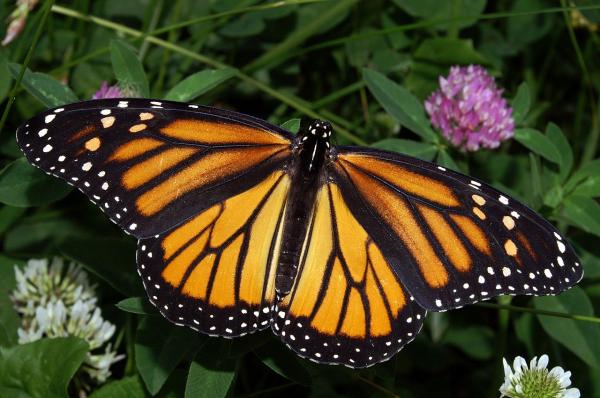
Did we answer your question "what is the state animal of...?" or did we miss the answer? If so, tell us in the comments section and we'll fix our list of animal emblems of the U.S.!
If you want to read similar articles to What is the State Animal Of..., we recommend you visit our Facts about the animal kingdom category.